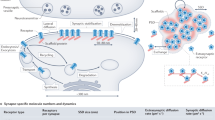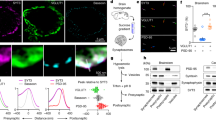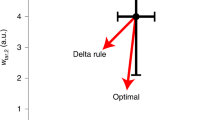Abstract
THE quantal hypothesis proposes that chemical synaptic transmission involves the probabilistic release of multimolecular packets of transmitter1. Analysis of the resulting trial-to-trial fluctuations in postsynaptic response can provide estimates both of the number of quanta released and of the size of their postsynaptic effect. This in turn permits the quantification of the relative contributions of pre- and postsynaptic factors to the strength of a given synapse. Quantal analysis of excitatory synapses in the hippocampus has proved difficult2–6 and has led to contradictory conclusions when applied to long-term potentiation7–14. Here we report the use of a combination of quantal analysis procedures to provide evidence that both pre- and postsynaptic changes can contribute substantially to the maintenance of long-term potentiation in the CA1 region of the hippocampus. The initial setting of the presynaptic release mechanism seems to determine their relative importance.
This is a preview of subscription content, access via your institution
Access options
Subscribe to this journal
Receive 51 print issues and online access
$199.00 per year
only $3.90 per issue
Buy this article
- Purchase on Springer Link
- Instant access to full article PDF
Prices may be subject to local taxes which are calculated during checkout
Similar content being viewed by others
References
del Castillo, J. & Katz, B. J. Physiol Lond. 124, 560–573 (1954).
Redman, S. Physiol. Rev. 70, 165–198 (1990).
Korn, H. & Faber, D. S. Trends Neurosci. 14, 439–445 (1991).
Larkman, A., Stratford, K. & Jack, J. Nature 350, 344–347 (1991).
Clements, J. Nature 353, 396 (1991).
Larkman, A., Stratford, K. & Jack, J. Nature 353, 396 (1991).
Voronin, L. L. Neuroscience 10, 1051–1069 (1983).
Malinow, R. & Tsien, R. W. Nature 346, 177–180 (1990).
Bekkers, J. M. & Stevens, C. F. Nature 346, 724–729 (1990).
Foster, T. C. & McNaughton, B. L. Hippocampus 1, 79–91 (1991).
Malinow, R. Science 252, 722–724 (1991).
Manabe, T., Renner, P. & Nicoll, R. A. Nature 355, 50–55 (1992).
Malgaroli, A. & Tsien, R. W. Nature 357, 134–139 (1992).
Kullmann, D. M. & Nicoll, R. A. Nature 357, 240–244 (1992).
Korn, H., Fassnacht, C. & Faber, D. S. Nature 350, 282 (1991).
Faber, D. S. & Korn, H. Biophys. J. 60, 1288–1294 (1991).
Muller, D., Joly, M. & Lynch, G. Science 242, 1694–1697 (1988).
Kauer, J. A., Malenka, R. C. & Nicoll, R. A. Neuron 1, 911–917 (1988).
Magleby, K. L. & Miller, D. C. J. Physiol., Lond 311, 267–287 (1981).
Edwards, F. A., Konnerth, A. & Sakmann, B. J. Physiol., Lond. 430, 213–249 (1990).
Author information
Authors and Affiliations
Rights and permissions
About this article
Cite this article
Larkman, A., Hannay, T., Stratford, K. et al. Presynaptic release probability influences the locus of long-term potentiation. Nature 360, 70–73 (1992). https://doi.org/10.1038/360070a0
Received:
Accepted:
Issue Date:
DOI: https://doi.org/10.1038/360070a0
This article is cited by
-
Structure and function of a neocortical synapse
Nature (2021)
-
Astrocyte-mediated switch in spike timing-dependent plasticity during hippocampal development
Nature Communications (2020)
-
SNAP-25 isoforms differentially regulate synaptic transmission and long-term synaptic plasticity at central synapses
Scientific Reports (2019)
-
Lentiviral Modulation of Wnt/β-Catenin Signaling Affects In Vivo LTP
Cellular and Molecular Neurobiology (2017)
-
Upregulation of transmitter release probability improves a conversion of synaptic analogue signals into neuronal digital spikes
Molecular Brain (2012)
Comments
By submitting a comment you agree to abide by our Terms and Community Guidelines. If you find something abusive or that does not comply with our terms or guidelines please flag it as inappropriate.



